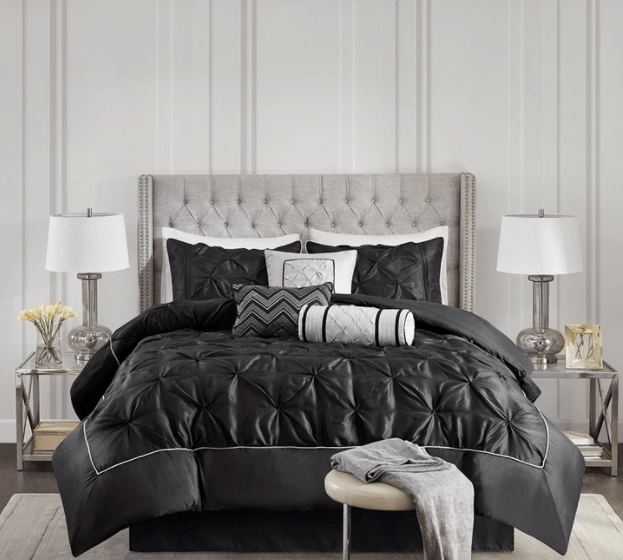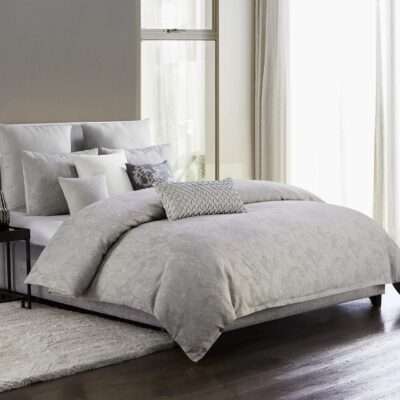Which Is a Warmer Duvet or a Comforter?
There is no better duo than winters and being curled up with a coffee mug. In winters, we prefer our bedding warm as much as we love our coffee hot. However, even though winters are fantastic, they can become a hassle if we don’t take measures to keep ourselves warm.
If we don’t have warm bedding, we are likely to toss and turn in bed shivering and miss out on our precious winter sleep. That’s why it is essential to know what you should buy this season, a duvet or a comforter.
What Should You Buy This Winter: Duvet or Comforter?
A comforter can appear a lot like a duvet at first glance. However, because a comforter is the final layer of a bed set, it differs from a duvet. It doesn’t require a cover and may be used as a stand-alone item on your bed.
Duvets are usually thicker than comforters because of their double layer. In addition, their duvet cover makes it easier for the duvet to be changed and decorated more often.
Comforters, on the other hand, are thinner. This is because they come without the duvet cover and hence are much lighter and less warm when compared to a duvet. However, because duvets have a higher fill power or loft than comforters, they are thicker and warmer.
Along with the warmness of the duvet, dark winter colors make it a perfect and beautiful accessory to relax. A rustic textured woven transverse stripe duvet may add a pleasant country feel to any bed. With a choice of blue or red stripes, Prescott Stripe Red Duvet Cover may be paired with various other colors to create a truly distinctive look.
The comforter is a better option for those who prefer a more compact, flat-lying surface than the duvet. If you don’t like a lot of fluff in your blankets, you may choose a comforter over a duvet.

The Luxury Comforters stand out in winter due to their true black hue. The collection has a variety of pieces of cloth sewed together to create depth and uses 100% polyester.
Which is Warmer?
Generally, a duvet will keep you warmer than a comforter will. However, the materials used to make either of the two can significantly impact how warm they are. Also, a comforter can either be warmer or cooler depending on the filling.
Cotton: Cotton is one of the most friendly materials for a comforter and duvet. The bedding is hypoallergenic and breathable because of the use of cotton stuffing. These are wonderful choices for mild winters because they are lightweight. Cotton is an excellent material to sleep on because it is soft and absorbent, making it ideal for a comfortable winter night’s rest. In addition, cotton helps keep the body cool and comfy.
Livia 6 Piece Cotton Comforter Set is a luxurious addition to any bedroom. There’s no better way to make your bedroom feel like a cozy cottage than with a 100 percent cotton comforter. The big and overstuffed comforter has a duvet-like finish. The two matching shams and two ornamental pillows, one square and one oblong, compliment the comforter perfectly. Also, the set is OEKO-TEX certification and free of dangerous substances and chemicals, offering the customer a high level of comfort and well-being.
Wool: Choose a duvet or comforter with a wool filling if it’s extremely cold. These can’t be washed. Therefore they’ll need to be cleaned by a professional. Comforters made of this material will keep you warm. Because of its particular texture, Wool is excellent at preserving body heat. The thick knotted threads are used to trap heat.
Down filling: Opting for a down filling is a comfortable and high-quality alternative. It’s a lot fluffier than wool, yet it’s still warm. Moreover, down filling is best for those with Wool allergies. Anyone who sleeps in the down fill will be kept warm and cozy. If you reside in an extremely cold climate, down is your best option for keeping warm.
Silk: Another luxurious choice is a blanket filled with silk fibers. Even though it’s absorbent and hypoallergenic, it requires much effort to maintain. Aside from cashmere and wool, there aren’t many more luscious fabrics than silk. There are numerous advantages to owning silk comforter covers, including a high comfort level for the vast majority of people.
Check out this Gia Blue Cotton/Silk Duvet Cover for a beautiful bedroom and warm winter. The silk duvet cover is a lovely shade of blue with a pretty floral printed decoration. The white flowers on the bedding look a lot like snowflakes, yet the silky duvet cover provides a summer warmth.
The hypoallergenic properties of silk make it excellent for anyone who suffers from allergies, while its airy properties allow excess heat to escape. Silk can absorb up to a third of its weight in water, yet it still allows any extra heat to escape.
Synthetic: Lastly, synthetic bedding, such as polyester or microfiber, is a popular choice. Today’s lightweight and warm choices are because they can hold warm air in place. It is also softer and fluffier than down or silk, and it isn’t as pricey.
The level of warmth a covering gives is the most significant consideration when making your selection. Winter is the perfect time to use thick wool blankets, heavy comforters, and duvets. For duvets, thicker duvet covers can also be used to increase the level of warmth.
Washing Duvet and Comforters in Winters
To keep your comforter and duvet clean, you should wash them 2 to 3 times a year. When used with a top sheet, a comforter can be made even more hypoallergenic. It’s best to wash your bedding when the season changes.

If your washing machine isn’t big enough to wash your comforter, you may want to take it to the dry cleaners instead. You could end up damaging your comforter if you try to wash it in a washing machine that is too small for it.




